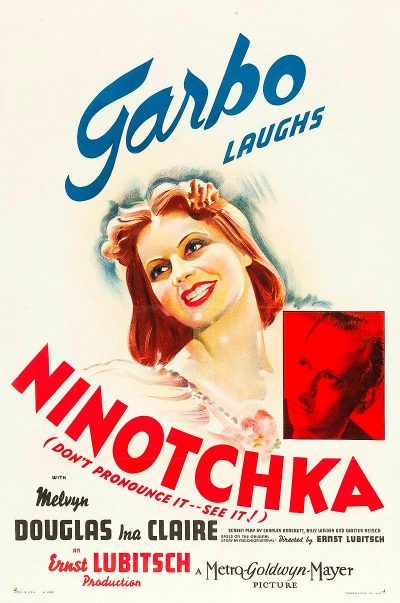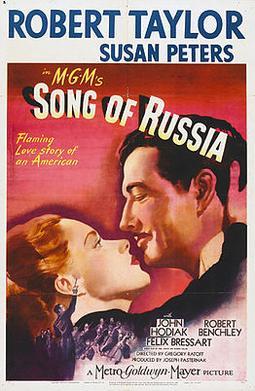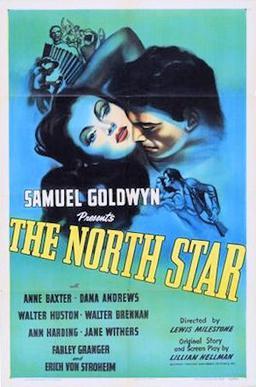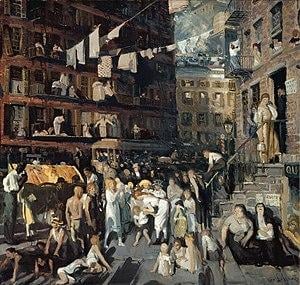
There was a brief moment in time in the 1940s, when the USA was at one with Russia or as it was known then, the Soviet Union. During the Second World War, America entered into the war on the same side as the Soviet Union against Nazi Germany, and Hollywood was rallied to the cause of victory against fascism.
In this article I will look at the cinema produced in the United States supporting the Allies during WWII, in this case the Soviet Union. After the war the political climate changed and HUAC (House Un-American Activities Committee) blacklisted actors, directors and screenwriters involved in making such films despite the fact that throughout the 1930s many films were made in a style sympathetic to the American working class, the realist style known as social realism. Therefore, the pro-Soviet films were basically a shift in location and accent, but not any dramatic change in content. I will look at examples of these social realist films made in Hollywood in the 1930s, films that are a far cry from contemporary Hollywood output in their depictions of ordinary people’s everyday struggles for survival.
First Red Scare
Initially the Bolshevik Revolution in Russia had ignited the first Red Scare in the United States. Massive strikes and race riots added to the fear of the spread of communism in America.
Films were made that depicted strikes and mail bombings as the work of Bolshevik activists, as external threats to a democratic nation, e.g. Virtuous Men (1919) [1], Dangerous Hours (1919) [2], and The Great Shadow (1920) [3]. The worldwide communist revolution failed to materialise, and the prosperity of the 1920s in the USA diminished criticism of the capitalist system. After the 1929 Great Crash, Hollywood made films which caricatured the Soviet Union, like Trouble in Paradise (1932) [4] and Ninotchka (1939) [5].
However, things soon changed with the onset of the Second World War. According to Andrei Cojoc:
“The United States’ attitude towards the Soviet Union shifted on 22nd of June 1941, when Hitler began sending his Panzers towards Moscow, and after December ’41 the alliance between the two opposite systems was a necessity. So, the American’s perceptions of the Soviet Union had to be shaped overnight so that FDR could receive popular support for entering the war on the Soviet Union’s side.”
The OWI (Office of War Information) was set up by executive order on 12th of June 1942 and put in charge of “advising Hollywood about the means to support the war effort”. A set of guidelines were formulated in a “Manual for the Motion Picture Industry” such as:
“In a comprehensive third chapter of the handbook, called “Who are our allies”, “Tinsel Town” is advised to learn more about their former enemy, the Soviet Union: We must €fight the unity lies about Russia (..), emphasize the might and heroism, the victory of the Russians. In a most surprising manner we find out that ‘we Americans reject communism, but we do not reject our Russian ally’ (United States, 1942).”
Pro-Soviet movies
Thereafter, nearly every major studio made pro-Soviet movies such as:
The North Star (1943) (Samuel Goldwin) [Watch online]. The film is about the resistance of Ukrainian villagers, through guerrilla tactics, against the German invaders of the Ukrainian SSR.
Song of Russia (1943) (MGM). American conductor John Meredith (Robert Taylor) and his manager, Hank Higgins (Robert Benchley), go to the Soviet Union shortly before the country is invaded by Germany. Meredith falls in love with beautiful Soviet pianist Nadya Stepanova (Susan Peters) while they travel throughout the country on a 40-city tour. Their bliss is destroyed by the German invasion.
Three Russian Girls (1943) (United Artists). The film depicts the life of a group of volunteer nurses for the Red Cross in 1941.
Mission to Moscow (1943) (Warner) [Watch online]. The film chronicles ambassador Davies’ impressions of the Soviet Union, his meetings with Stalin, and his overall opinion of the Soviet Union and its ties with the United States.
Days of Glory (1944) (RKO). Tells the story of a group of Soviet guerrillas fighting back during the 1941 Nazi invasion of Russia.
The Boy from Stalingrad (1943) (Columbia). Five Russian youngsters and an English boy form a guerilla band which harasses the Germans stationed in their village.
In my research I have found 11 American pro-Soviet films altogether. In addition to the above mentioned films there is also:
Counter Attack (1945) [Watch online]. Two Russians trapped in a collapsed building with seven enemy German soldiers during World War II.
The Battle of Russia (1943) [Watch online]. Documentary by Frank Capra
The film begins with an overview of previous failed attempts to conquer
Russia.The vast natural resources of the Soviet Union are then described
and show why the land is such a hot prize for conquerors. The film then
covers the German conquests of the Balkans and ends with the Siege of
Leningrad and the Battle of Stalingrad.
Miss V from Moscow (1942) [Watch online]
The Miss V of the title is Vera Marova, a Soviet spy sent to Paris to
impersonate her lookalike, a German spy recently liquidated by the
French Resistance.
Our Russian Front (1942). Documentary
Walter Huston narrates a World War II documentary intended to bolster
United States support for the USSR’s war efforts. Created using front
line footage taken by Russian battlefield cameramen, and archive footage
of Averell Harriman, Joseph Stalin, and Semyon Timoshenko, the film was
edited in the US.
Russian Rhapsody (1944) [Watch online] (Merrie Melodies cartoon)
Infuriated by his soldiers’ constant failure, Fuehrer Adolf Hitler
announces his decision via a radio broadcast at a “New Odor” rally that
he will personally fly a heavy bomber to attack the Russians. On the way
to Moscow, Russian ‘gremlins from the Kremlin’ sneak onto the plane in
flight and without Hitler’s being aware of what’s going on, begin to
dismantle it.
A common theme of the narrative films is the depiction of Russians as similar to Americans. The villages could be villages in America with their independent cheerfulness and progress, and capped off with Russian accents and Russian names. The main theme is that, as Cojoc writes, “by diminishing differences between the two cultures, one can see that both are fighting for the same goals”, fighting for humanity’s sake with as little reference as possible to the communist government. Some of the films were particularly popular, with The North Star, for example, being nominated for six Oscars. They have been criticised as propaganda films which, of course, they were. All sides in the war made propaganda films. They were made to promote the Allies view of the war, and some were successful and popular.
Documentaries were made to explain why a country which was ridiculed and dismissed, was now an ally. The Battle of Russia (1943), the fifth film in Frank Capra’s Why We Fight documentary series, is the longest film of the series and has two parts. The series was originally made to explain to the US soldiers why they were involved in the war but was subsequently shown to the public as well. Capra’s style was to let the footage speak for itself and so he used a lot of found or captured enemy footage. It was nominated for an Academy Award for Best Documentary Feature, and even popular in the Soviet Union.
While it might seem extraordinary that Hollywood was making such films about the Russians in the early 1940s, the emphasis on working class values and solidarity was not new. During the 1930s, Hollywood had already been making pro-working class, social realist films. It didn’t take much effort to make films with a similar ideology but set in Russia with Russian accents.
However, considering the hullabaloo surrounding the red scare of the “McCarthyism” era [1950-1954], these examples of American social realism cinema are rare indeed, if we take note that it is estimated that Hollywood made around 9,838 films in the 1930s, and about 7,900 films in the 1940s.
Social Realism
Social Realism was a popular art movement between the two wars, especially as a reaction to the hardship ordinary people faced as a result of the Great Crash in 1929. It was a style that went back to the Realism of French artists, like Honoré Daumier, Gustave Courbet and Jean-François Millet in the 19th-century. In the USA, social realism was well established by a group of artists called the Ashcan school during the late 19th and early 20th century. They were not impressed by Impressionism and wanted to make art that was more engaged with life. Their paintings were based on the working class and the realities of urban life. Subjects included: street kids, prostitutes, alcoholics, subways, crowded tenements, washing hung out to dry, theaters, and wrestlers.
Ashcan School, George Bellows, Cliff Dwellers, 1913, oil on canvas. Los Angeles County Museum of Art
After the Great Crash, President Franklin D. Roosevelt initiated a series of programs, public work projects, financial reforms, and regulations between 1933 and 1939. In the arts, “the New Deal arts programs emphasized regionalism, social realism, class conflict, proletarian interpretations and audience participation. The unstoppable collective powers of the common man, contrasted to the failure of individualism, was a favorite theme.” Like the Ashcan painters, social realist films depicted true-to-life characters and locations, with common themes of: social injustice, racial injustice, economic hardship, and the working class as heroes.
Frank Capra made a series of such films in the 1930s and 1940s [6] which were very successful, such as:
Platinum Blonde (1931)
Stewart “Stew” Smith (Robert Williams), ace reporter for the Post, is
assigned to get the story about the latest escapade of playboy Michael
Schuyler. He marries the wealthy Anne Schuyler but then realises that he
is no longer his own man.
American Madness (1932)
At the Union National Bank, the directors are concerned because they
think that bank president Tom Dickson has loaned too much money to
people who are bad risks during the Great Depression era, and they
threaten to replace him.
Mr. Smith Goes to Washington (1939)
The film is about a newly appointed United States Senator who fights against a corrupt political system.
Meet John Doe (1941)
The film is about a “grassroots” political campaign created unwittingly
by a newspaper columnist with the involvement of a hired homeless man
and pursued by the paper’s wealthy owner.
It’s a Wonderful Life (1946)
George Bailey, a man who has given up his personal dreams in order to
help others in his community, and whose thoughts of suicide on Christmas
Eve brings about the intervention of his guardian angel, Clarence
Odbody.
Other examples of social realist films of the time were:
The Sin of Nora Moran (1933)
Nora Moran, a young woman with a difficult and tragic past, is sentenced
to die for a murder that she did not commit. She could easily reveal
the truth and save her own life, if only it would not damage the lives,
careers and reputations of those whom she loves.
Success at Any Price (1934)
Joe, an amoral capitalist and boyfriend of Sarah Griswold, gets a job as
a clerk in a New York City advertising agency and starts to work his
way to the top.
Riffraff (1936)
Fisherman Dutch Muller organizes a strike with his fellow thugs from the
fishery, including the beautiful but tough Hattie Tuttle, against the
owners of a tuna cannery.
The President’s Mystery (1936)
The film deals with a “problem Mr. Roosevelt submitted … whether it was
possible for a man, weary of faithless friends and a wasted life, to
convert a $5,000,000 estate into cash, disappear and start anew in some
worth-while activity.”
The General Died at Dawn (1936)
Tells the story of a mercenary who meets a beautiful girl while trying
to keep arms from getting to a vicious warlord in war-torn China.
Marked Woman (1937)
Tells the story of a woman who dares to stand up to one of the city’s most powerful gangsters.
Blockade (1938)
During the Spanish Civil War a farmer takes up arms to fight for the Republican side.
Dust Be My Destiny (1939)
Joe Bell (John Garfield) becomes embittered after he is jailed for 16
months for something he did not do. He grew up a homless man who is
tried for murder and changes courts attitude to vagrant drifters.
The Man I Married (alternative title I Married a Nazi) (1940)
A successful, and yet naive American woman, art critic Carol Cabbott
(Joan Bennett), is married to German Eric Hoffman (Francis Lederer) who
turns out to be an active and enthusiastic Nazi.
We Who Are Young (1940)
Two young office workers working at the same large firm secretly marry
and defy their employer’s policy against coworker fraternization. When
the marriage is discovered, Margy (Turner) is fired. This causes the
newlyweds to face serious financial struggles and Bill (Shelton) pursues
desperate, perhaps even illegal, measures to make ends meet.
Tom, Dick and Harry (1941)
Janie (Ginger Rogers) is a telephone operator and a daydreamer. Her
fondest wish is to land a rich husband. She gets engaged to three men
from different socio-economic backgrounds and has to make a choice of
which one to marry.
House Un-American Activities Committee (HUAC)
By the late 1940s, things had changed dramatically and the House Un-American Activities Committee (HUAC), set up in 1938 by the United States House of Representatives, began to investigate alleged disloyalty and subversive activities on the part of private citizens. In 1947, the committee:
“held nine days of hearings into alleged communist propaganda and influence in the Hollywood motion picture industry. After conviction on contempt of Congress charges for refusal to answer some questions posed by committee members, “The Hollywood Ten” were blacklisted by the industry. Eventually, more than 300 artists – including directors, radio commentators, actors, and particularly screenwriters – were boycotted by the studios. Some, like Charlie Chaplin, Orson Welles, Alan Lomax, Paul Robeson, and Yip Harburg, left the U.S. or went underground to find work. Others like Dalton Trumbo wrote under pseudonyms or the names of colleagues.”
Anticommunist tract from the 1950s, decrying the “REDS of Hollywood and Broadway”
Abraham Polonsky, screenwriter and director (Body and Soul (1947), Force of Evil (with Ira Wolfert) (1948) (also Director), I Can Get It for You Wholesale (with Vera Caspary) (1951), Tell Them Willie Boy Is Here (1969) (also Director)), was blacklisted after June 1950. In an interview in Red Hollywood [7] he stated:
“There was no plot to put social content into pictures. The plot was intellectual. Social content is what pictures are about. You can’t make a picture about human life without social content, and social content meant, in fact, the social content of these people: how the world was divided up, how it worked economically, socially, morally, and so on. You gotta show the rich are shitty and the poor are beautiful, its important that you gotta show that anybody who works as being exploited: those are general professional ideas that are current among the least educated among the radicals. But there is the social content that comes from a general philosophical attitude towards the world, of society. That's what counts.”
In the overall scheme of things these films were a tiny percentage of the general Hollywood output of the time. Furthermore, their content tended to revolve around working class issues and struggles against social and economic injustice, that is, typical content of social realism, as opposed to the direct pro-socialist and revolutionary content of socialist realism.
The struggling movement of social realism in cinema met a similar fate to the Ashcan school of artists in the 1910s. The ‘advent of modernism in the United States spelled the end of the Ashcan school’s provocative reputation. With the Armory Show of 1913 and the opening of more galleries in the 1910s promoting the work of Cubists, Fauves, and Expressionists’, the radical social realism of the Ashcan school was swamped by Romanticism (in the form of Modernism) and another movement critical of the status quo was killed off.
Ultimately though, the social realist films of the 1930s and 1940s serve as examples of a cinema that treated humans with dignity and promoted solidarity in times of war and peace, which makes them as watchable today as in the times when they were created
Films about Hollywood on trial:
1/ The Hollywood Ten (1950) https://www.youtube.com/watch?v=taancRcLQ8o
2/ Holywood on Trial (1976) https://www.imdb.com/title/tt0074635/?ref_=fn_al_tt_1
3/ Blacklist: Hollywood on Trial (1995) (AMC Documentary) https://www.youtube.com/watch?v=g4jlaJph-cI
4/ Red Hollywood (1996) https://www.imdb.com/title/tt0332344/
Notes
[1] Virtuous Men (1919). When Bob Stokes, a wealthy New York clubman, loses his fortune, he is jilted by his fiancée Marcia Fontaine. He then wanders to an upstate lumber camp where he impresses the owner, Henry Willard, with his leadership and fighting abilities. After Stokes quells a strike engineered by the previous foreman, Robert Brummon, who is really a Bolshevik agitator, to prevent shipments of lumber for government contracts, Brummon, seeking revenge, sets the forest on fire, but Stokes controls it. Willard then sends for Stokes to oversee his New York shipyards where a government “mystery ship” is under construction. After Stokes and Willard’s daughter Helen fall in love, Brummon gets Marcia to attempt to seduce Stokes. Marcia lures Stokes to her apartment, where Brummon plans to kill him, but he escapes when he learns that a time bomb is set to destroy the ship. Stokes finds the bomb just before it explodes and throws it into the water. The saboteurs are captured, and together, Stokes and Helen watch the ship launch. https://www.imdb.com/title/tt0010846/
[2] Dangerous Hours (1919) is an American silent drama film directed by Fred Niblo. Prints of the film survive in the UCLA Film and Television Archive. It premiered in February 1920. The film was based on a short story “A Prodigal in Utopia” published in the Saturday Evening Post. The film’s working title was Americanism (Versus Bolshevism), which was the title of a pamphlet published by Ole Hanson, the mayor of Seattle who claimed to have broken the Seattle General Strike in 1919. https://en.wikipedia.org/wiki/Dangerous_Hours
[3] The Great Shadow (1920) is an American silent drama film directed by Harley Knoles and starring Tyrone Power Sr., Donald Hall and Dorothy Bernard. Jim McDonald, the foreman of a shipbuilding plant and head of the labor union, strives to combat the anarchistic propaganda being put forth by Klimoff, the leader of a Bolshevik gang whose goal is to disrupt the country with strikes and anarchy. Despite McDonald’s efforts, a strike is called, resulting in chaos. McDonald’s child is knocked down by runaway horses abandoned by their striking driver, and dies. Mob scenes take place in America, as well as in Russia. Eventually, the unrest is quelled with an armistice called between Capital and Labor for a year, during which time wages are to be increased to reflect the cost of living, and leaders are to work out a common plan for their mutual advantage. The strikers now realize that they have been pawns of the Bolsheviks and call off the strike, agreeing to the plan. https://www.imdb.com/title/tt0011247/plotsummary?ref_=tt_ov_pl https://en.wikipedia.org/wiki/The_Great_Shadow_(film)
[4] Trouble in Paradise (1932). High class European thief Gaston Monescu meets his soulmate Lily, a pickpocket masquerading as a countess. The two join forces and come under the employ of Mme. Colet, the beautiful owner of the Colet perfume company. Gaston works as Mme. Colet’s personal secretary under the alias Monsieur La Valle. Rumors start to fly as ‘M. La Valle’ steals Mme. Colet away from her other suitors. When the secret of his true identity catches up to him, Gaston is caught between the two beautiful women. https://www.imdb.com/title/tt0023622/?ref_=nv_sr_srsg_0 https://en.wikipedia.org/wiki/Trouble_in_Paradise_(1932_film)
[5] Ninotchka (1939) is an American romantic comedy film. One of the first American films which, under the cover of a satirical, light romance, depicted the Soviet Union under Joseph Stalin as being rigid and gray, in this instance comparing it with the free and sunny Parisian society of pre-war years. https://en.wikipedia.org/wiki/Ninotchka
[6] See also my article: Corrupt Elites: “Mr. Smith Goes to Washington”: Individual and Collective Struggles in the Films of Frank Capra. https://www.globalresearch.ca/individual-collective-struggles-films-frank-capra/5713881
[7] See Abraham Polonosky 11:20 Red Hollywood: https://www.imdb.com/title/tt0332344/
Caoimhghin Ó Croidheáin is an Irish artist, lecturer and writer. His artwork consists of paintings based on contemporary geopolitical themes as well as Irish history and cityscapes of Dublin. His blog of critical writing based on cinema, art and politics along with research on a database of Realist and Social Realist art from around the world can be viewed country by country here. Currently working on a book entitled Against Romanticism: From Enlightenment to Enfrightenment and the Culture of Slavery. It looks at philosophy, politics and the history of 10 different art forms arguing that Romanticism is dominating modern culture to the detriment of Enlightenment ideals.
He is a Research Associate of the Centre for Research on Globalization (CRG).



















No comments:
Post a Comment